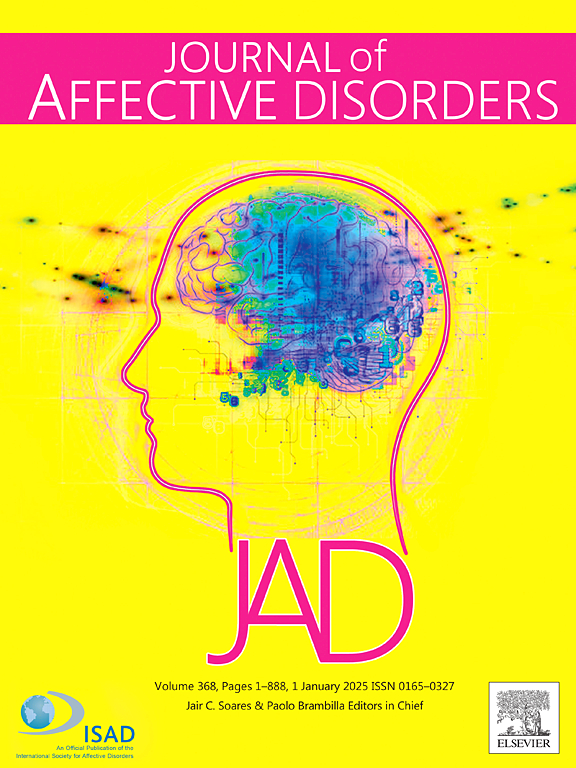短睡眠时间和日间户外活动对青少年心理健康的影响:应激敏感性-恢复模型分析
IF 4.9
2区 医学
Q1 CLINICAL NEUROLOGY
引用次数: 0
摘要
精神健康障碍是全球日益严峻的公共卫生挑战。本研究旨在利用应激敏感性-恢复模型来确定青少年睡眠时间、日间户外活动与主要心理健康结果之间的关系。方法对云南省学生常见病调查资料进行分析。多因素逻辑回归评估了每个变量对心理健康的影响,而亚组分析和相互作用测试检验了睡眠时间、白天户外活动和心理健康之间关系的稳定性。孟德尔随机化分析评估了因果效应。结果分析包括来自953所监测学校的204,158名12-18岁的参与者。调整协变量后,抑郁情绪的患病率从18.81%(12-13岁)增加到24.89%(16-18岁);女性患病率高于男性(1:1.36)。高中生(26.04%)明显高于初中生(21.41%)和中职高中生(18.42%)。与白天户外活动2小时及以上的学生(2小时及以上的学生占19.96%,3小时及以上的学生占19.70%)相比,白天户外活动2小时及以上的学生抑郁情绪的患病率(24.40%)更高。短睡眠时间介导了白天户外活动减少与抑郁情绪或情感障碍风险增加之间的关联,支持应激敏感性-恢复模型。结论考虑到年龄和性别差异,睡眠时间和白天户外活动是情绪健康的关键决定因素。局限性由于有和没有缺失数据的参与者之间基线特征的差异,可能存在抽样偏倚。本文章由计算机程序翻译,如有差异,请以英文原文为准。
Short sleep duration and daytime outdoor activities effects on adolescents mental health: A stress susceptibility-recovery model analysis
Background
Mental health disorders are a growing public health challenge globally. This study aimed to utilize the Stress Susceptibility-Recovery Model to identify the relationship between sleep duration, daytime outdoor activities, and major mental health outcomes among adolescents.
Methods
Data from the Yunnan Students' Common Disease Survey was analyzed. Multi-factorial logistic regression assessed the impact of each variable on mental health, while subgroup analyses and interaction tests examined the stability of the association between sleep duration, daytime outdoor activity, and mental health. Mendelian Randomization analysis assessed causal effects.
Results
The analysis included 204,158 participants aged 12–18 from 953 surveillance schools. After adjusting for covariates, the prevalence of depressive mood increased from 18.81 % (12–13 years) to 24.89 % (16–18 years); Females had a higher prevalence than males (1:1.36). Senior high school students (26.04 %) had a significantly higher rate than junior high school (21.41 %), and vocational high school students (18.42 %). Students with <2 h of daytime outdoor activity had a higher prevalence of depressive mood (24.40 %) compared to those with 2 or more hours of daytime outdoor activity (19.96 % for 2 h and 19.70 % for 3 or more hours). Short sleep duration mediated the association between reduced daytime outdoor activity and increased depressive mood or affective disorders risk, supporting the Stress Susceptibility-recovery Model.
Conclusions
Sleep duration and daytime outdoor activity were key determinants of emotional well-being, considering aging and gender disparities.
Limitations
Potential sampling bias due to differences in baseline characteristics between participants with and without missing data.
求助全文
通过发布文献求助,成功后即可免费获取论文全文。
去求助
来源期刊

Journal of affective disorders
医学-精神病学
CiteScore
10.90
自引率
6.10%
发文量
1319
审稿时长
9.3 weeks
期刊介绍:
The Journal of Affective Disorders publishes papers concerned with affective disorders in the widest sense: depression, mania, mood spectrum, emotions and personality, anxiety and stress. It is interdisciplinary and aims to bring together different approaches for a diverse readership. Top quality papers will be accepted dealing with any aspect of affective disorders, including neuroimaging, cognitive neurosciences, genetics, molecular biology, experimental and clinical neurosciences, pharmacology, neuroimmunoendocrinology, intervention and treatment trials.
 求助内容:
求助内容: 应助结果提醒方式:
应助结果提醒方式:


